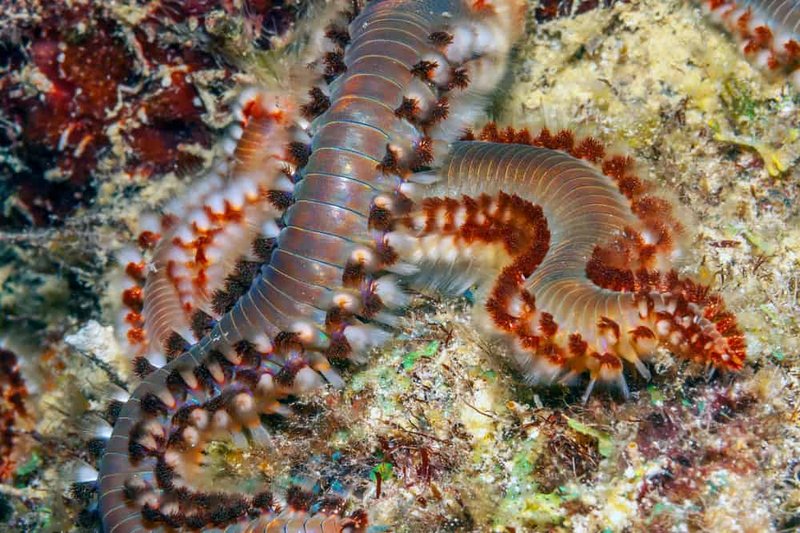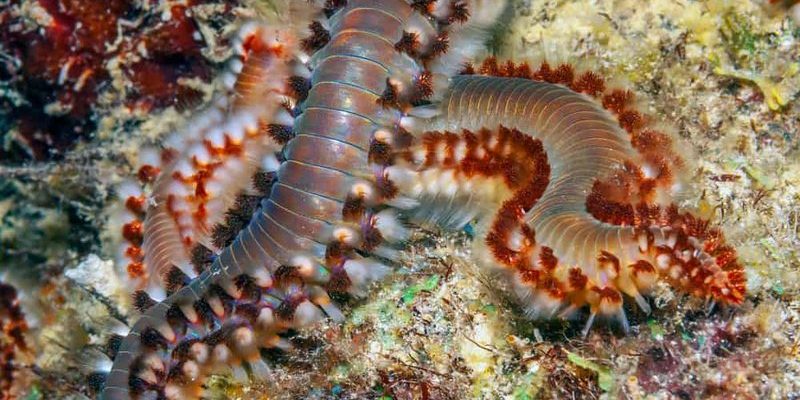
Bristle worms are more than just aquatic worms; they’re essential players in the ecosystem of your aquarium. They can be scavengers, eating detritus and other organic matter, but can also attract attention when they start nibbling on your more delicate fish or invertebrates. Understanding their dietary preferences can significantly impact how you care for your aquatic environment. So, grab your favorite drink, and let’s dive into the intriguing world of bristle worms!
What Are Bristle Worms?
Bristle worms belong to the Polychaete family, a type of segmented worm found in both salt and freshwater. They come in various colors, shapes, and sizes, with some even glowing in fluorescent hues. Picture them as the multitaskers of the underwater world! Their bristles, or setae, help them navigate their environment and can also give them a defensive edge against predators.
These worms can vary in size from just a few millimeters to over a meter long. In an aquarium, you might spot them scuttling around your substrate, munching on leftovers from fish meals or decomposing plant matter. Honestly, they play a vital role in nutrient recycling within the tank. They help break down waste products, which can improve water quality.
Here’s the thing: while many people initially see bristle worms as pests, they’re actually beneficial. They can help aerate the substrate, promoting a healthier environment for your fish and plants. Just think of them as nature’s little clean-up crew!
What Do Bristle Worms Eat?
You might be wondering, “What exactly do bristle worms chow down on?” The answer is a bit more complex than you’d think. Bristle worms are omnivorous, which means they munch on a variety of food sources. In an aquarium, they typically eat leftover fish food, algae, decomposing organic matter, and even dead or dying creatures.
– Fish Food: When you feed your fish, some food inevitably sinks to the bottom. Bristle worms quickly and eagerly take advantage of this free meal, helping reduce waste in your tank. They’ll feast on flakes, pellets, and even frozen food that doesn’t get eaten by the fish.
– Detritus: This is organic matter that settles on the substrate, such as decomposed plant material, uneaten fish food, and fish waste. Bristle worms play a crucial role in breaking this down, returning nutrients to the ecosystem.
– Live Prey: While bristle worms can nibble on live prey, they usually do so opportunistically. If fish or invertebrates die, they won’t hesitate to take a bite – they’re scavengers at heart.
So, whether it’s fish food floating by or a morsel of decaying matter, bristle worms are ready to gobble it up!
Do Bristle Worms Pose a Threat to Fish?
This is where things can get a bit tricky. Many aquarists are concerned that bristle worms might attack their fish or other tank inhabitants. While bristle worms are not aggressive predators, their opportunistic eating habits can create some issues. If fish are weak, sick, or injured, bristle worms might see them as an easy meal.
– In Healthy Tanks: If your fish are healthy and well-fed, bristle worms generally won’t pose a real threat. They mainly scavenge and help keep the tank clean.
– In Stressed Conditions: If your fish become stressed or show signs of illness, bristle worms might take advantage. This is not because they are actively hunting, but rather due to their natural scavenger instincts kicking in.
To reduce any risks, monitor the health of your fish and maintain good water quality. If you notice a sudden explosion of bristle worms, it might indicate overfeeding or issues with tank cleanliness.
How to Manage Bristle Worm Populations
If you’re one of those aquarium enthusiasts who have found a colony of bristle worms, you might be asking, “How do I manage their numbers?” Here are some simple strategies:
1. Control Feeding: Overfeeding is one of the primary reasons bristle worm populations surge. Keep an eye on your feeding habits and only supply what your fish can consume within a few minutes. This reduces excess food that bristle worms can feast upon.
2. Regular Tank Cleanings: Maintaining a clean aquarium is essential for both your fish and any scavengers like bristle worms. Regularly vacuum the substrate and perform water changes to keep conditions optimal. This limits the available food sources for bristle worms.
3. Adding Predators: Some fish species, known as bristle worm predators, can help keep their numbers in check. For example, some wrasse species love to munch on bristle worms. However, be cautious; these fish can also nibble on your invertebrates!
4. Manual Removal: If bristle worms become a nuisance, you can remove them by hand (with gloves!) or with a trap designed to catch them. This can be a time-consuming process but can help manage their populations.
Managing bristle worms is all about balance. A few in your tank can be beneficial, while too many can lead to problems.
Are Bristle Worms Safe for Reef Tanks?
If you have a reef tank, you might wonder about the compatibility of bristle worms with your precious coral and invertebrates. The good news? Bristle worms can coexist peacefully in many reef tanks, especially when their populations are kept in check.
However, here’s what you should consider:
– Coral Safety: Most corals are safe from bristle worms, as these creatures primarily scavenge rather than hunt. However, if the worms are starving, they might nibble on soft corals. It’s essential to ensure there’s enough food for everyone!
– Invertebrate Caution: Some invertebrates can be at risk, particularly smaller or weak ones. If you notice any decline in your invertebrates, check the bristle worm population and monitor the overall health of your tank.
To keep the balance right, it’s vital to maintain water quality and a healthy ecosystem. This not only benefits your fish and corals but also keeps bristle worms from becoming a problem.
Bristle worms might seem intimidating at first, especially if you’re worried about their potential to snack on your fish. But when you understand their habits and dietary preferences, you can see just how beneficial they can be in your aquarium. They eat fish food, detritus, and even play a role in recycling nutrients.
So, rather than viewing bristle worms purely as pests, consider them a part of your aquarium’s complex ecosystem—like tiny janitors keeping everything tidy. With a little care and monitoring, you can enjoy the beauty of your aquatic life while ensuring everyone thrives. Embrace the bristle worm; they might just surprise you with their contribution to your underwater world!

